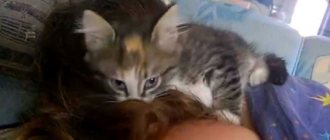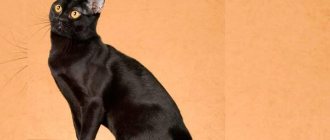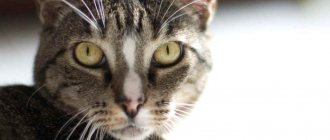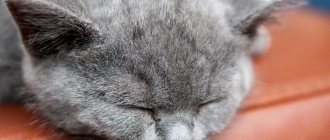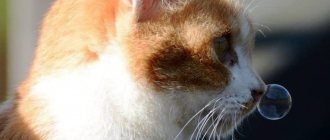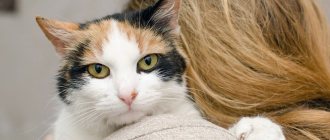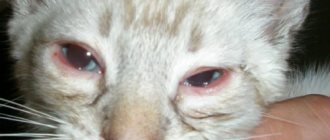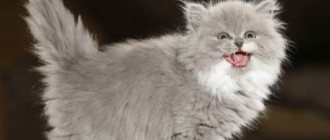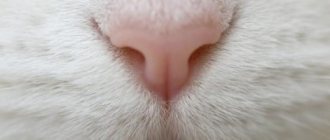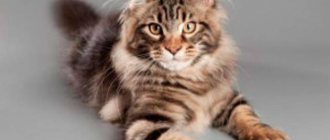It can be difficult for owners to determine the age of an animal, especially if it came into the family as an adult. Therefore, usually when cats turn gray, owners think that the animal is old or sick. However, veterinarians say that a change in color does not always indicate aging or disease.
The most telling sign of old age is poor dental health. It is by this criterion that veterinary specialists determine the approximate age of the pet. There are special tables that reflect changes in teeth over the years of life.
But can the appearance of gray hairs signal that the animal has entered old age? Or does a change in coat color indicate a problem with the body? These questions often concern responsible pet owners.
Treatment methods
If the owner discovers that his pet is losing important elements of touch, then it is necessary to assess the general condition of the animal.
In case of previous activity, there is no need to worry. It should be noted that some breeds tend to break their whiskers. In most cases it is noted among sphinxes. If the loss of whiskers is accompanied by accompanying symptoms, you should visit a veterinarian. The earlier the disease is diagnosed, the easier it is to cope with it. The goal of therapy is to stop the loss of whiskers, eliminate concomitant symptoms and the underlying disease. When visiting a veterinary clinic, an examination and tests are prescribed. Based on the results obtained, effective treatment is determined. The owner needs to feed his furry friend properly, carry out preventive measures to combat parasites, and take him for examination to the veterinarian. Proper care, nutrition and a caring attitude will allow the cat to recover in a short time, a healthy pet will delight the owner and all household members.
Combination of dasatinib and quercetin
One of the first drugs with a proven senolytic effect was the combination of the antitumor drug dasatinib and the flavonoid quercetin. The first is capable of destroying aging fat cells, and the second is capable of destroying aging vascular cells. It has been proven that the combination exhibits a more powerful senolytic effect than each drug individually.
Studies have shown that after administration of dasatinib and quercetin to mice, systemic regeneration occurred - slowing the development of osteoporosis, improving the function of the cardiovascular system, and increasing physical endurance. In addition, the combination of the two drugs also demonstrated effectiveness in animals that were weakened by radiation therapy, with the results of a single injection lasting for seven months.
The combination of dasatinib and quercetin has not yet been approved. Moreover: the formula itself is under study, and the creation of the drug is still quite far away.
Should I worry?
If your cat has gray hair or areas where the coat color has changed, do not panic
Observe your pet, paying special attention to the animal's appetite and activity level. If the cat eats and plays with pleasure, most likely the appearance of gray hair is a natural process
Changes in coat color often occur after the summer period, when the animal spent a lot of time outdoors during a country holiday. This symptom does not pose a big threat to the health of the animal, but in the future it is better to think about limiting walks during the hottest hours.
Alarm bells should be a cause for concern. If the animal has become lethargic, has lost its appetite and the cat prefers to sleep most of the day, this, without a doubt, requires the intervention of specialists. Worry should also be caused by deterioration in the quality of wool and the appearance of tangles.
Turning points
The owner of a cat with a serious illness needs to decide what moment is considered a turning point. Even animals with poor health, older cats, as a rule, have good days. Are you not ready to make a serious decision just because your pet sometimes becomes very ill? But prepare for the fact that the moment of need to make a decision may come in the future. If there are many more bad days than good ones, the animal will begin to suffer from severe pain that cannot be relieved by drugs, and the quality of its life will greatly deteriorate - this is the very moment.
It is painful to part with a pet, but attempts to prolong its life are not always appropriate. It is more important that the cat live a full life, and not exist. If the quality of life has greatly decreased, euthanasia becomes the only salvation for the doomed animal. If your cat is suffering greatly and medicine is powerless to help her, you have the right to decide to alleviate her suffering in the only available way.
Determining the age of the kitten
The most common reason for trying to estimate the age of pets is the decision to adopt a stray baby or adult cat.
If you need to determine the age of a kitten, it is enough to evaluate its development, and this is very simple. Suppose you found a squeaking lump, brought it home and are at a loss about what to do next... what to feed it, should it be warmed, how to care for it? The answers to all these questions depend on age, and it is determined by a number of characteristics.
Umbilical cord
Examine the kitten's abdomen, is the umbilical cord still in place? This means that you are dealing with a newborn baby who will not survive without proper care. On the first day the umbilical cord is wet, on the second day it dries out a little, and on the third (usually) it falls off.
At home, with proper complementary feeding, heating and care, a newborn kitten has a chance (not a guarantee) to survive. On the street, such a baby will die within 10–20 hours.
Eyes
At the first stage of development, two stages of the formation of a kitten’s eyes can be distinguished: the opening and acquisition of pigmentation. In newborn kittens, the eyes are closed, not glued together, but covered with a single flap of skin. The older the kitten, the more visible the furrow becomes, which will divide into the upper and lower eyelids.
The intellectual elite of the cat world
Representatives of the Siamese breed are distinguished by excellent memory and intelligence, are well trained, willingly respond to their name, and can walk in a collar and on a harness.
The leading properties of intelligence are curiosity, the ability to solve new problems and adapt to change. These qualities are fully inherent in the “Siamese”. They easily adapt to unfamiliar surroundings, are playful and trainable even in adulthood.
Curiosity, combined with keen eyesight, excellent jumping ability and long, dexterous fingers, does not leave a single secret corner for them in all accessible rooms. All boxes will be opened by them, and cabinets will be examined from top to bottom.
The tendency to explore new places can be dangerous: having independently escaped into the unknown street world through an open door or window, a Siamese cat is unlikely to live long. The lack of undercoat makes this breed, which is tropical in origin, vulnerable to colds.
Helping an aging cat
Grooming
It becomes difficult for an older cat to care for its fur. A healthy animal thoroughly washes and combs its fur with its tongue, but with pain in the spine and joints, or weak muscles, it becomes impossible to reach some areas.
The owner should comb the cat every day with a slicker brush, and also run a slightly damp grooming mitt over the fur. This will avoid the formation of tangles or at least detect them in time. If the wool has already felted, a hygienic haircut is necessary.
Inspection and nail trimming
In older animals, the change of the horny cover of the claws may be impaired, especially if the cat does not use the scratching post as actively as before. An overgrown claw bends and digs into the pad, causing severe pain and suppuration. Particularly susceptible to this problem:
- Persians;
- exotics;
- Scottish and British cats.
If the claw once digs into the pad, it will need to be trimmed regularly with a nail clipper (once every 2 weeks).
Stimulating activity
As cats age, they become increasingly less interested in their environment, preferring to lie in a warm place and doze. But to slow down muscle atrophy, aging of joints and to help the intestines work better, furry couch potatoes need to move.
Many cats that do not play on their own are willing to run if their owner teases them. For this there is:
- laser pointers;
- fishing rods with feathers;
- or a regular bow on a string.
Appetite stimulation
As cats age, their sense of smell and taste becomes dull, which can lead to a loss of interest in their usual food. Food with increased attractiveness and aroma, food additives (anchovy juice, tuna, sardines) can solve the problem. The food is heated (possibly in the microwave), then the smell is stronger.
You can mix your favorite treat and recommended food, or use supplements such as VIYO Reinforces prebiotic drink for older cats.
Visit to the tray
In older animals, intestinal motility slows down and constipation may occur. Feces become dry and hard, making going to the toilet painful and stressful. The owner needs to monitor the regularity of bowel movements, stimulating timely bowel movements if necessary. To do this, use internally:
- malt paste (for hair removal);
- Vaseline oil;
- Duphalac.
There are special diets high in fiber.
Regular urination is equally important. The tray should be easily accessible for an elderly kitty
If the house is large enough, it makes sense to place several cat litter boxes in different rooms. When there are several floors, this is a prerequisite.
Asylum
Every cat needs a secluded place where no one will disturb it. But for an old animal that has difficulty jumping, it becomes more difficult to find such a place: the cat stops climbing onto the closet and jumping on the furniture.
The pet is given a house on the lower tier - it can be an ordinary cardboard box. Children should be told that their furry friend needs some rest and can't play with them like he used to. Sometimes it is necessary to isolate a cat from dogs, because in old age it is more difficult for her to defend herself and protect her “place in the sun.”
Stability
Cats don't like change and can even get sick due to stressful situations in their lives. The older the animal becomes, the more sensitive it perceives any innovations. Although we cannot protect our pet from global changes (the birth of children, moving to a new home), we should maintain the usual routine as much as possible. Do not rearrange furniture, feed at the same time.
Often owners, noticing signs of old age in a cat, bring a new, young pet into the house. Some even believe that this will benefit the old lady - the kitten will play with her and stir her up a little. But it’s better to wait to purchase a kitten, since its appearance will significantly spoil your pet’s peaceful old age. It is difficult for older animals to compete with their young relatives, and they experience severe stress.
Love
Even if at a young age the pet had an independent character, in old age the attitude towards signs of attention changes. The owner should show his cat affection every day. Stroking and scratching can be very pleasant, and they also have medical benefits. A light massage stimulates blood circulation, improves the condition of the skin and muscles.
Communication as a way of individual nutrition
Siamese cats and kittens need the most tangible manifestations of love and personal attention. Charming blue-eyed dogs will not miss the opportunity to jump onto the laps of their beloved owners and receive a proper portion of affection. They are, of course, capable of remaining alone, but not for too long. They need at least half an hour of daily personal communication - and better, of course, more often, more... Even more!
Therefore, cats of this breed are not suitable for those who are rarely at home. Alternatively, you can get a Siamese company of two or more masked jumpers, so that the mustachioed tailed ones entertain each other
At the same time, they must get used to living together from an early age, learning to share their master’s affection and attention without conflicts.
If you add an additional pet of the same breed to an adult Siamese cat, he will experience the most burning, clawed and biting jealousy in his own skin.
The same fate will befall other domestic animals and, in general, any unknown person who dares to encroach on the attention of their owners. Therefore, as a rule, Siamese cats greet guests with obvious distrust
A well-modulated, low, slightly hoarse, but loud voice is an additional tool for communication between these cats and people. Siamese enchantresses really love to be talked to - and respond with heartfelt roulades.
A sonorous voice is also an effective way to achieve what you want: food, drink, entertainment! And cats of this breed declare their needs loudly, right up to neighboring apartments, especially in the seasonal “March”.
Most of the typical cat qualities are expressed in the sensitive, observant, emotional Siamese cats with an added strength. For example, they have an exceptionally subtle ability to find a sore spot in people and lay on top of it. However, one should not attribute special mercy and compassion to miraculous creatures - these cats are devoid of undercoat, often freeze and, having discovered a source of inflammation with an elevated temperature, sit on it like on a heating pad.
Contact with children is a difficult area for the willful and proud breed. Definitely, Siamese cats are absolutely unsuitable company for babies, especially crawling babies. Only from the age of six, when a child can well control touching the fur and clearly distinguish unceremonious squeezing from stroking that is pleasant to every cat’s soul, can one firmly count on the loyalty of this pet.
How cats go gray
It happens that colorless hairs appear even in kittens and young individuals. Sometimes whole areas of lighter fur appear on the fur. Suddenly, owners discover that their pet, which was previously monochromatic from the tips of its whiskers to the tip of its tail, now has, for example, a light-colored bib.
The animal may not have the usual silver hairs, which we usually consider gray, but brown or gray. The fur seems to fade, changing its color to a lighter and more faded color. This phenomenon is often mistaken for a sign of vitamin deficiency or dermatological problems.
Owners of older cats note that over the years, entire areas of faded fur have appeared on the animal. The fur especially changes color on the pet’s back, in the area of the muzzle and tail. It happens that by old age a pet completely changes color and becomes brown instead of black, for example.
When pets go gray
The fur can change color in a pet of any age. Sometimes this happens even in young children. But often animals actually turn gray from old age. After 7 years of age, cats develop light hairs on their back, face and ears. As a rule, this is accompanied by additional signs of aging.
In some cases, owners notice a change in the saturation of the color of the pet’s coat. Moreover, the change can affect both the entire coat and its individual sections. This phenomenon applies to both older animals and young individuals. Moreover, the color of the coat can change almost completely.
Another situation when a cat's fur turns gray is stress or illness. The reason for such changes can be a move, separation from the owner, or poor health of the pet. As a rule, in addition to the appearance of gray hair, in such situations the condition of the coat as a whole worsens.
Why does my cat have gray hair?
If gray hairs appear in a young animal, and the pet has no signs of illness, it is most likely a matter of genetics. Normally, a cat's fur color and pattern may change throughout its life. Most often, the color is formed by one and a half years, but there are cases when the color of the coat changes even later.
If gray hairs appear on an older animal, this can be considered a sign of aging. Just like humans, cats experience a decrease in pigment content in their hair as they age.
At the same time, it is important to take into account other criteria for the cat’s vitality: mobility, mood, condition of the skin and teeth.
Another reason for changes in fur color in a cat may be pathological processes in the animal’s body. As a rule, the situation is not limited to the appearance of gray hair and the animal experiences other alarming symptoms indicating illness. Sometimes the cause of the problem is a food allergy.
Gray hair in cats
Date of publication: 09.12.2019
It can be difficult for owners to determine the age of an animal, especially if it came into the family as an adult. Therefore, usually when cats turn gray, owners think that the animal is old or sick. However, veterinarians say that a change in color does not always indicate aging or illness.
The most telling sign of old age is poor dental health. It is by this criterion that veterinary specialists determine the approximate age of the pet. There are special tables that reflect changes in teeth over the years of life.
But can the appearance of gray hairs signal that the animal has entered old age? Or does a change in coat color indicate a problem with the body? These questions often concern responsible pet owners.
Salt and pepper
Due to the lack of melanin, the structure of the hair changes: it becomes dry and hard. Therefore, hair requires more careful care and often forces you to change your hairstyle.
Dye your hair or leave it natural (“salt and pepper”), it’s up to you. You should not dye your hair just because of gray hair at the temples. It is enough to use a tinted shampoo to match the natural color, but you need to keep it on your hair a little longer than with simple tinting.
The need for permanent coloring usually arises when gray hair reaches more than 40%.
When it comes to coloring gray hair, there are a lot of nuances to consider. The structure of gray hair is more porous and loose, so it absorbs dye more easily and loses color faster (the dye is washed off when washing your hair 5-8 times). Therefore, gray hair has to be dyed more often. Hair coloring experts recommend using additional care products (they form a film that covers the scales on the surface of the hair, which prevents the pigment from being washed out).
Is it possible to go gray instantly? More details
Why does hair turn grey?
According to Miami dermatologist Dr. Jill Weiber, the hair of babies in the womb is colorless. And only when melanocytes—skin cells that produce the pigment melanin—begin to form in the fetus’s body, do the strands acquire color. Hair color depends entirely on the distribution, type and amount of melanin in the middle layer of the hair shaft. This complex combination gives birth to black, brown, light blond, red strands and their various shades. Over the years, the production of melanocytes is slowed down by the enzyme telomerase, which adds special DNA sequences to eukaryotic cells. This leads to gradual graying of hair.
To make your wish come true, write it on a piece of paper and place it under the icon on Trinity Sunday.
The risk of contracting Covid from a passerby is low: how to meet friends safely
To make fertilizer for the grass, I mix beer, soda and shampoo.
What to do if your cat turns gray
If a cat's fur has turned gray and signs of a painful condition have appeared, owners should not postpone a visit to a specialist. With the Petstory app, you can get online advice from a certified veterinarian.
Without leaving your home, you will learn about the possible causes of gray hairs in an animal and, if necessary, draw up a plan for examining your cat with your doctor. Your veterinarian will help assess the severity of symptoms and inform you what tests and investigations you need to start treatment with.
If the cause of coat problems is an incorrect diet, using the Petstory app you can get advice on changing food, prescribing special supplements to improve the condition of the coat, and also learn about treating allergies.
The day before yesterday, a kitten (7 months old) experienced severe stress. ((( And today I noticed a white hair on his black back. Is this connected? Now there will always be a gray hair in this place? Is it possible to pull it out? What if it turns gray again. How to stop the process?
No, it won't turn gray. I had the same cat, a few white hairs on the black skin
Yes, they don’t turn gray from stress. It’s just that the color of the skin of animals sometimes changes. My dog was black, but by the time she was a year old it became salt and pepper. The other one was light-colored—by the age of one and a half, it looked like she was wearing a dark vest.
Are you crazy - pulling out the cat's fur? Does this hair bother you that much? And if you get more gray hair with age, will you start dyeing it?
New features and design have appeared for the version of the Woman.ru Forum on computers. Tell us, what are your impressions of the changes?
Why did you scare the poor cat so much? What kind of stress?
Why did you scare the poor cat so much? What kind of stress?
Probably the roommate caused a row. Beat furniture.
Author, don't worry. Animals, not people, do not turn gray from stress. But the tearing will cause stress to the cat
the kitten saw the author having sex
They turn gray from stress. My cat lives as an adult, calm. She brought a very active kitten into the house. The kitten was always bothering him, wouldn’t let him sleep, and tried to play all the time. The poor cat was looking for the 5th corner. The cat (Siamese) has white fur on its black face! After 2 months the kitten was given away. After some time, the cat’s face became black again. So, don’t worry, the author, it will pass as soon as the molting begins.
They turn gray from stress. My cat lives as an adult, calm. She brought a very active kitten into the house. The kitten was always bothering him, wouldn’t let him sleep, and tried to play all the time. The poor cat was looking for the 5th corner. The cat (Siamese) has white fur on its black face! After 2 months the kitten was given away. After some time, the cat’s face became black again. So, don’t worry, the author, it will pass as soon as the molting begins.
I really hope! He ran out into the corridor, someone wanted to steal him, then she barely found him, he hit his face, there were no scratches on one of his paws, he was sitting so pitifully dirty, trembling (((((The next day in the evening I noticed this hair. if only He was there before, I would have noticed And now he seems to have a tic when he sleeps. Previously, he seemed to sleep without twitching ((((
He also jerks his whole body when he sleeps. All the muscles on the face suddenly twitch, this has never happened before
He also jerks his whole body when he sleeps. All the muscles on the face suddenly twitch, this has never happened before
Should I worry?
If your cat has gray hair or areas where the coat color has changed, do not panic
Observe your pet, paying special attention to the animal's appetite and activity level. If the cat eats and plays with pleasure, most likely the appearance of gray hair is a natural process
Changes in coat color often occur after the summer period, when the animal spent a lot of time outdoors during a country holiday. This symptom does not pose a big threat to the health of the animal, but in the future it is better to think about limiting walks during the hottest hours.
Alarm bells should be a cause for concern. If the animal has become lethargic, has lost its appetite and the cat prefers to sleep most of the day, this, without a doubt, requires the intervention of specialists. Worry should also be caused by deterioration in the quality of wool and the appearance of tangles.
Are cat diseases dangerous for humans?
Most feline skin diseases do not pose a danger to humans, but it is recommended to wear gloves when caring for an unhealthy animal. Some bacteria and fungi are not able to penetrate a healthy body, but can cause harm if the immune system is weakened.
The only contagious disease listed is ringworm. In humans, it manifests itself as flaking, spots, itching and hair loss. To prevent infection, you need to minimize contact with the cat and wash your hands with soap after handling the animal.
The main danger of dermatological feline diseases lies in the increased risk of developing allergies in humans. When an animal is sick, its skin is renewed more often, and dander and saliva particles get into the air. These are potential allergens. The more irritant enters the human body, the higher the risk of unwanted reactions. Such diseases are most dangerous for those who already have allergies. To prevent attacks, it is recommended to do wet cleaning more often.
Causes of loss
If your cat's whiskers fall out, don't panic right away. First of all, having noticed such a phenomenon, it is necessary to observe for some time the behavior, general condition of the pet, and whether a new whisker grows in place of the one that fell out. In most cases, the loss of a mustache is not associated with any disease or abnormality in the body. Some pets lose them as a result of fights with other individuals, others are too curious and come close to the fire, after which the whiskers simply become scorched.
It is normal for cats to change their whiskers. Vibrissae can fall out at any time, regardless of the molting period of the individual.
In some cases, disappearance of whiskers may indicate developing health problems in the animal. Such reasons include the following factors:
- hypothyroidism is a disease associated with increased activity of the thyroid gland;
- infections of bacterial etiology;
- the presence of parasites in the body;
- diabetes of any type;
- allergic reaction;
- metabolic disorder.
Hearing loss
Hearing loss does not occur in old age in all cats, but it is very common. If you call your cat several times and she doesn't respond, her hearing may not be as good as it used to be.
There are different degrees of deafness, with some cats having only a slight degree. Other older cats may become completely deaf. If you notice any major changes in your cat's feelings or behavior, you will need to contact your veterinarian to rule out another, more serious health problem.
The same thing happens with loss of vision and smell. The breakdown of your pet's senses will lead to attention deficits, and he may begin to become clumsy in his movements and show changes in his mood, so he may be somewhat irritable.
When do cats go gray?
Silvery hairs in an animal's fur are a side effect of heredity or age. For example, black cats “grey” in early adolescence. Although this process is not at all connected with gray hair itself. If a black animal has gray or smoky individuals in its family, then it may well experience a one-, two-, or even three-fold change in color, called “recolor.” Black kittens acquire their color only when they are closer to one and a half years old; until this moment, their color can vary from brown to ashen.
In addition to the “overcoloring” characteristic of black cats, there are a number of other reasons that cause gray hair, but are in no way related to age. An animal's color can be affected by changing seasons or temperatures. For example, the fur of Burmese, Siamese or Himalayan cats darkens during the cold season, while in the summer it takes on a different shade, fading in the sun. True, such a change in color cannot be called gray hair, because it goes away on its own over time.
Some owners confuse a change in the pattern on an animal's fur with gray hair. A certain set of genes is responsible for it, which can be activated only in adulthood. The white hairs that appear look like gray hairs, but they are not, retaining their pigment.
Subscribe to our newsletter and get a free veterinary consultation Thanks for subscribing!
Causes of gray hair:
- Disease - after an illness or surgery, owners can often find tufts of gray hair on the animal. Allergies leave the same imprint.
- Nutrition - lack of amino acids, copper and macronutrients often leads to gray hair in cats. It is these chemical elements that are responsible for the production of melanin, and their lack in food leads not only to gray hair, but also to a general pallor of color.
- Stress - just like people, cats turn gray from grief or strong emotions. Moving or separation from the owner can lead to a change in color.
- Age - over time, the color of the animal changes, but it is quite difficult to determine the exact period, since heredity also plays a role. Some become gray as early as 3-5 years of age, while others retain their bright coat until death. Average statistical data suggests that the appearance of gray hair is normal at 8-12 years of age.
Contrary to popular belief, the appearance of gray hair does not indicate the imminent death of a pet and mandatory changes in its behavior (sleep more, move less). Rather, changes in pigmentation indicate a hereditary predisposition. But if, along with gray hair, you notice a change in the animal’s eating habits or behavior, or the cat looks sick, then be sure to show your pet to the veterinarian.
Many owners are not inclined to identify the cat’s physiology with their own, and, having discovered a couple of colorless hairs in their pet’s fur, they make a false conclusion: the cat is turning gray, which means he is sick. Worries are often in vain. Over time, the hair of many mammals - primates, dogs, people, and cats - loses pigmentation. Graying is just a side effect of age or heredity. It is not associated with skin changes and hair loss, the behavior and well-being of the animal, or a negative psychological environment. Therefore, if you notice silver hair in a cat’s skin, you should not panic: with proper care and nutrition, this is a typical process not related to health.
Why does hair turn gray
With age, the number of cells in the follicles, and, accordingly, the coloring pigment, decreases. Therefore, new hair, especially after 30 years, may appear gray. In addition to natural cell depletion, graying can be associated with genetics, stress, vitamin deficiencies and certain diseases.
The cause may also be vitiligo, a condition in which the production of melanocytes in certain areas of the skin stops.
0.5–2% of the human population has vitiligo
Possible factors for graying:
- Age from 30 years
- Genetics
- Stress
- Micronutrient deficiency
- Diseases
- Vitiligo
- Taking certain medications
- Smoking
- Climate and ecology
Research shows that by the age of 50, half the population has 50% gray hair. Scientists call this the “50/50/50 rule.”
Although gray hair is associated with old age, silver hair can also be found in young people, and in rare cases even in children. Therefore, there are three types of graying: physiological - age-related; premature - occurring at a young age; congenital - associated with a hereditary lack of pigment in the hair.
Stress
Natural hair loss and replacement in a healthy person occurs every few years. One hair cycle can last up to seven years. The more hair you lose, the faster your melanocytes use up their melanin production potential, and the more likely it is that new hair will grow gray.
80–120 thousand number of hairs on the head of healthy men and women
Stress affects hair roots in different ways. The most common side effect is telogen effluvium. This is a condition in which hair falls out three times faster than normal.
In rare cases, hair turns gray suddenly. This occurs with Marie Antoinette syndrome, which turned completely gray the night before her execution.
The exact mechanisms of how stress affects a person's graying hair require further study. So far, scientists have been able to study the effect of stress only on mice: when exposed to it, their fur becomes gray. But how far the research results can be applied to humans is still unknown.
Lack of nutrients
Studies of people with early gray hair show that premature graying is often characterized by micro- and macronutrient deficiencies. Low levels of B vitamins: folic acid, biotin and vitamin B12, as well as vitamin D, iron and selenium, accompany the appearance of gray hair in childhood and adolescence.
Smoking
In 2010, scientists conducted a study that showed that smokers are 2.5 times more likely to experience early gray hair than non-smokers.
One reason is that smoking, like air pollution, affects the creation of reactive oxygen species. These are unstable oxygen molecules that cause oxidative stress in the body, including disrupting the biochemical process of melanin production.
Diseases
For most people, the appearance of gray hair is associated with age-related changes. However, sometimes graying is an indicator of health problems, especially if it occurs at a young age.
Early gray hair may indicate autoimmune and chronic diseases, metabolic disorders, and some syndromes. For example, diseases of the thyroid gland, as well as tuberculous sclerosis, in which tumors arise in different organs.
Premature appearance of gray hair is also a sign of an increased risk of developing Alzheimer's disease, Parkinson's disease, and cardiovascular diseases.
Some medications
Hair bleaching as a result of taking medications is a rare occurrence. However, in some people, certain medications given intravenously may cause changes or loss of hair color. Research shows that medications that are associated with hair color loss in people include the following:
| A drug | Purpose |
| Chloroquine | Antimalarial |
| Acitretin | Treatment of severe resistant psoriasis |
| Etretinate | Treatment of severe psoriasis |
| Some centrally acting milrelaxants | Treatment of muscle spasms associated with the musculoskeletal system |
| Mirtazapine | Antidepressant |
The effect of most of these drugs on hair color is a reversible process. After taking the medication, the hair grows back colored with natural pigment.
Salt and pepper
Due to the lack of melanin, the structure of the hair changes: it becomes dry and hard. Therefore, hair requires more careful care and often forces you to change your hairstyle.
Dye your hair or leave it natural (“salt and pepper”), it’s up to you. You should not dye your hair just because of gray hair at the temples. It is enough to use a tinted shampoo to match the natural color, but you need to keep it on your hair a little longer than with simple tinting.
The need for permanent coloring usually arises when gray hair reaches more than 40%.
When it comes to coloring gray hair, there are a lot of nuances to consider. The structure of gray hair is more porous and loose, so it absorbs dye more easily and loses color faster (the dye is washed off when washing your hair 5-8 times). Therefore, gray hair has to be dyed more often. Hair coloring experts recommend using additional care products (they form a film that covers the scales on the surface of the hair, which prevents the pigment from being washed out).
Is it possible to go gray instantly? More details
Premature gray hair in dogs
An important reason why dogs can go gray prematurely is that they are stressed. Stress can be caused by many reasons, such as loneliness, feelings of abandonment, death of a loved one, the arrival of a child or other pet, etc.
D...
A stressed dog shows reluctance, sadness or anxiety, all of which are amplified and cause premature gray hair to appear.
It is also important to know that dogs are greatly influenced by their owners and therefore feel the stress and anxiety of their family. If you are incredibly stressed, this anxiety may be unknowingly passed on to your pet.
Determining the age of an adult cat
Finding out the age of a cat if you decide to get an older pet is a little more difficult. You can tell the exact age of a cat only if you know when it was born; in other cases, there is a possibility of a significant error. However, there is no need to worry, since it is quite possible to distinguish a young cat from an adult and an elderly one.
Tough
The easiest way to assess age is to examine the dentition. Let us immediately make a reservation that the following indicators are very approximate, since they depend on the quality of care, accommodation and metabolic rate of the animal.
- Age 1–2 years: teeth look “like new”, that is, white, healthy, strong, with a bluish tint, not worn out.
- Age 2–2.5 years: the first wear of the incisors appears.
- Age 2.5–3 years: yellowness and a small amount of tartar appear. If your teeth have been taken care of, this sign is not relevant.
- Age 3–3.5 years: wear on the incisors is clearly visible.
- Age 5 years: the first wear of the fangs appears.
- Ages 5–7 years: obvious wear on the lower incisors.
- Ages 8–10 years: obvious wear of the upper incisors.
- Age over 10 years: gradual loss of lower incisors.
- Age over 11 years: gradual loss of upper incisors.
- Age 14–15 years: incisors are completely or partially absent, gradual loss of canines.
Determining the age of a cat by the presence or absence of tartar is not very logical, since the formation of growths depends on the type of food. If you adopt a cat from the street, a clearer indicator is tooth wear, as stray animals brush their teeth on branches and grass, often eat hard food, or may lose a tooth due to disease.
Estimating age by teeth has a very large error if the cat has chronic gum problems.
According to other signs
The approximate age of a cat can also be determined intuitively by assessing it by external signs. The nuance is that a well-groomed animal will look young even at 5 years old, but a street cat may seem much older, although it is not yet 3 years old. There is an opinion that gray hair is a sign of old age, but this is not true.
The only time this statement is true is if you are determining age by looking at a cat's whiskers. The older the animal, the more developed its whiskers. Cats older than 9–10 years have hard, long, but colorless (gray) whiskers. However, this indicator is very conditional, since the length, thickness and presence of a mustache are hereditary factors.
Cats with thick, bushy and very long whiskers are considered to have or are likely to have vision problems.
Determining age by the color and condition of the coat is not relevant if you do not know in what conditions the cat lived, but even here several nuances can be highlighted:
- White fur on the chin is not necessarily gray hair.
- Gray hair is colorless or has a silver tint.
- It is almost impossible to determine gray hair in a light-colored cat.
- Black cats practically do not turn grey, but change color to brown.
- In older cats, the fur around the eyes becomes less dense.
Another indicator of age is the eyes, or more precisely, the condition of the iris. The older the cat, the lighter the eye color. Again, some cats have irises that are genetically light in color (blue, hazel, pearl, light moss). In outdoor cats, their eyes fade much faster. In animals that lived indoors and did not go outside, bright eye pigmentation lasts longer.
Changes in eating habits and weight
As your cat gets older, you will find that she eats less or more slowly than before, and her previous appetite will disappear. This happens because over time the digestive system slows down, which can also cause problems with constipation. As digestion becomes slower and more difficult, your cat may also lose weight. If you notice this sign of aging in your cat, it is necessary to adjust the food portions and make changes to her diet.
On the other hand, because older cats are less active, they can gain weight easily and may even become obese. Physical changes are very relative. The situation can get worse if you don't watch out for these symptoms, as it could also be a symptom of diabetes. A common symptom of diabetes in cats is constant eating throughout the day and constant thirst. If you notice this, consult your veterinarian as soon as possible.
Should I worry?
If your cat has gray hair or areas where the coat color has changed, do not panic
Observe your pet, paying special attention to the animal's appetite and activity level. If the cat eats and plays with pleasure, most likely the appearance of gray hair is a natural process
Changes in coat color often occur after the summer period, when the animal spent a lot of time outdoors during a country holiday. This symptom does not pose a big threat to the health of the animal, but in the future it is better to think about limiting walks during the hottest hours.
Alarm bells should be a cause for concern. If the animal has become lethargic, has lost its appetite and the cat prefers to sleep most of the day, this, without a doubt, requires the intervention of specialists. Worry should also be caused by deterioration in the quality of wool and the appearance of tangles.
Age-related changes
Another inevitable reason why a cat's fur color has changed is age. And not only very old age, but also 5 years and even 3 years. The color usually darkens with age.
The multi-colored patterned colors gradually blur and turn into mush. The matter is complicated by ticking - coloring each hair with several transverse rings of light and dark tones. It should be noted that the patterned color cannot appear without ticking: these characteristics are genetically related.
